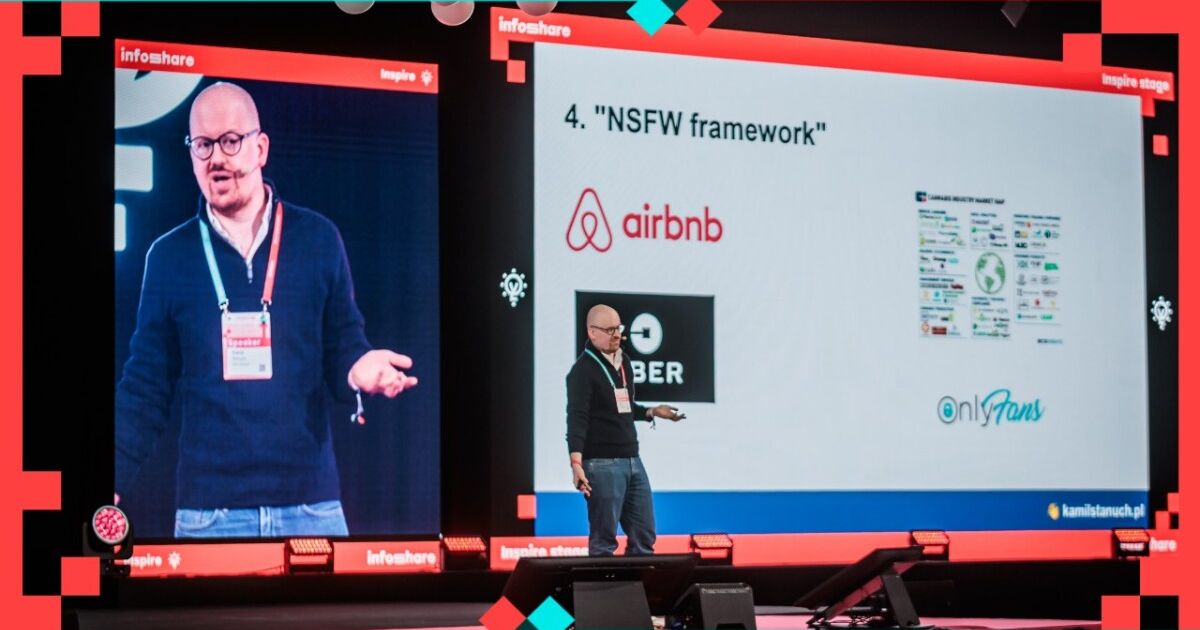VIEW SPEECH SUMMARY
1. Speaker Background and Perspective
- Speaker has experience running companies and in the betting/gambling industry.
- Since 2021, works as an angel investor, likening it to betting on uncertain outcomes.
- Skeptical about predicting the future because if the future was known, betting markets would be obsolete.
2. Challenges in Predicting the Future
- People tend to extrapolate current trends linearly into the future (growth fallacy).
- Historical examples show erroneous futuristic expectations (e.g., 19th-century visions of flying firemen).
- Innovation often follows a non-linear, complex path influenced by black swans and butterfly effects.
- We tend to repeat the same thinking patterns (path dependence), which limits true innovation.
3. Examples Illustrating Path Dependence and Misguided Innovation
- Housing construction largely unchanged for centuries—simply adding drones or robots to old methods is path dependent.
- Reinventing rather than automating (e.g., 3D printing houses vs. robot bricklaying) is often overlooked.
- Germany’s HIV home testing example: a well-intentioned idea led to mass false positives and psychological risks, showing unintended consequences.
- "Charlie Sheen effect" demonstrates how unexpected cultural moments can drive massive behavior change far beyond anticipated “black swan” events.
4. Technology Adoption and Hype Cycles
- Gartner hype cycle charts technology maturity over about 10-15 years with phases: trigger, inflated expectations, trough, and slow adoption.
- The speaker advises looking back at older hype cycles to spot long-term trends rather than chasing every new "hot" tech.
- Some lagging technologies (3D printing, bioprinting, hearing aids printing) quietly revolutionize industries unnoticed.
- Social phenomena like QR codes took decades to become mainstream—innovation adoption is often slow and uneven.
5. Innovations from Grey Markets and Marginal Areas
- Grey markets often lead innovation by meeting consumer demand ahead of regulation.
- Examples: Napster (illegal music sharing) inspired legal services like iTunes and Spotify; Airbnb and Uber entered legal gray areas initially.
- Emerging markets like cannabis and paid porn businesses challenge conventional norms and open new investment opportunities.
6. Laugh Heuristics and Early Adoption
- Many now-big innovations were initially laughed at as trivial/toy-like (QR codes, NFTs, iPhone).
- Early innovators and older populations may adopt technology differently due to "leapfrog" effects (skipping legacy technology).
- Wealthy or laggard groups sometimes stick to older technology even when newer, faster options exist.
7. What Won’t Change in the Next 10 Years
- Inspired by Jeff Bezos: core consumer desires like fast delivery, large choice, and low prices remain constant.
- Dave McClure's observation: lucrative apps focus on earning/saving money, fame, or relationships (getting laid).
8. The Curse of Moore’s Law
- While computing power doubles every ~2 years, many industries like agriculture and energy grow slowly (~2% per year).
- Outside of tech bubbles, most sectors evolve gradually rather than explosively.
- Many foundational technologies have existed for over a century with modest change.
9. Final Reflections
- Innovations may come in surprising forms (e.g., flying cars delayed, but 140-character social media emerged).
- Understanding innovation requires patience, recognizing indirect effects, and avoiding simplistic linear projections.
---
**Actionable Items / Tasks:**
- When evaluating new technologies, consider long-term trends, looking back at older hype cycles instead of chasing hype.
- Explore "grey markets" and marginal legal areas for startup ideas that align with unmet consumer demands.
- Focus innovation efforts not only on automation of old processes but also on fundamentally reinventing solutions.
- Use frameworks like Jeff Bezos’s “what won’t change” to prioritize business strategies around stable consumer needs.
- Be aware of non-linear influence factors like cultural effects ("Charlie Sheen effect") which can drastically shift markets.
- Avoid the trap of path dependence by challenging assumptions based on past methods.
- Consider the diversity of adopters (early innovators, laggards, wealthy clients) when designing user experiences or products.
- Recognize that meaningful innovation adoption often takes years or decades; plan long-term.
- Speaker has experience running companies and in the betting/gambling industry.
- Since 2021, works as an angel investor, likening it to betting on uncertain outcomes.
- Skeptical about predicting the future because if the future was known, betting markets would be obsolete.
2. Challenges in Predicting the Future
- People tend to extrapolate current trends linearly into the future (growth fallacy).
- Historical examples show erroneous futuristic expectations (e.g., 19th-century visions of flying firemen).
- Innovation often follows a non-linear, complex path influenced by black swans and butterfly effects.
- We tend to repeat the same thinking patterns (path dependence), which limits true innovation.
3. Examples Illustrating Path Dependence and Misguided Innovation
- Housing construction largely unchanged for centuries—simply adding drones or robots to old methods is path dependent.
- Reinventing rather than automating (e.g., 3D printing houses vs. robot bricklaying) is often overlooked.
- Germany’s HIV home testing example: a well-intentioned idea led to mass false positives and psychological risks, showing unintended consequences.
- "Charlie Sheen effect" demonstrates how unexpected cultural moments can drive massive behavior change far beyond anticipated “black swan” events.
4. Technology Adoption and Hype Cycles
- Gartner hype cycle charts technology maturity over about 10-15 years with phases: trigger, inflated expectations, trough, and slow adoption.
- The speaker advises looking back at older hype cycles to spot long-term trends rather than chasing every new "hot" tech.
- Some lagging technologies (3D printing, bioprinting, hearing aids printing) quietly revolutionize industries unnoticed.
- Social phenomena like QR codes took decades to become mainstream—innovation adoption is often slow and uneven.
5. Innovations from Grey Markets and Marginal Areas
- Grey markets often lead innovation by meeting consumer demand ahead of regulation.
- Examples: Napster (illegal music sharing) inspired legal services like iTunes and Spotify; Airbnb and Uber entered legal gray areas initially.
- Emerging markets like cannabis and paid porn businesses challenge conventional norms and open new investment opportunities.
6. Laugh Heuristics and Early Adoption
- Many now-big innovations were initially laughed at as trivial/toy-like (QR codes, NFTs, iPhone).
- Early innovators and older populations may adopt technology differently due to "leapfrog" effects (skipping legacy technology).
- Wealthy or laggard groups sometimes stick to older technology even when newer, faster options exist.
7. What Won’t Change in the Next 10 Years
- Inspired by Jeff Bezos: core consumer desires like fast delivery, large choice, and low prices remain constant.
- Dave McClure's observation: lucrative apps focus on earning/saving money, fame, or relationships (getting laid).
8. The Curse of Moore’s Law
- While computing power doubles every ~2 years, many industries like agriculture and energy grow slowly (~2% per year).
- Outside of tech bubbles, most sectors evolve gradually rather than explosively.
- Many foundational technologies have existed for over a century with modest change.
9. Final Reflections
- Innovations may come in surprising forms (e.g., flying cars delayed, but 140-character social media emerged).
- Understanding innovation requires patience, recognizing indirect effects, and avoiding simplistic linear projections.
---
**Actionable Items / Tasks:**
- When evaluating new technologies, consider long-term trends, looking back at older hype cycles instead of chasing hype.
- Explore "grey markets" and marginal legal areas for startup ideas that align with unmet consumer demands.
- Focus innovation efforts not only on automation of old processes but also on fundamentally reinventing solutions.
- Use frameworks like Jeff Bezos’s “what won’t change” to prioritize business strategies around stable consumer needs.
- Be aware of non-linear influence factors like cultural effects ("Charlie Sheen effect") which can drastically shift markets.
- Avoid the trap of path dependence by challenging assumptions based on past methods.
- Consider the diversity of adopters (early innovators, laggards, wealthy clients) when designing user experiences or products.
- Recognize that meaningful innovation adoption often takes years or decades; plan long-term.
Reverse Thinking: Path dependance, Charlie Sheen and 7 Models to Think About Future in Terms of Anti-Trends
12:30 - 12:50, 27th of May (Tuesday) 2025 / INSPIRE STAGE
Most predictions assume that the future is a linear or exponential extension of the present—but what if that’s completely wrong? From the Curse of Moore’s Law to the Charlie Sheen Effect, this talk explores 8 contrarian models for forecasting the future. Learn why the next big thing often starts as a toy, why Germans abandoned mass HIV tests, what is 'laughing heuristic' and 'NSFW framework' and why drones shouldn't build houses.
AUDIENCE:
Startup
Scaleup
Profitable Company
TRACK:
Business & Tech trends
Growth
Startup / VC
TOPICS:
FutureNow
Startup
VC



